Tesco's Strategic Management: SWOT, PESTEL, and Generic Strategies
VerifiedAdded on 2023/01/17
|12
|3784
|47
Report
AI Summary
This report provides a comprehensive strategic analysis of Tesco, a major player in the UK retail sector. It begins with an overview of the retail industry and Tesco's global presence, followed by an analysis of the company's internal environment using SWOT analysis, highlighting strengths such as market dominance and weaknesses like past operational failures. The report then delves into Tesco's external environment using PESTEL analysis, examining the political, economic, social, technological, environmental, and legal factors impacting the company. It discusses the strategic relevance of these factors. The report recommends the most appropriate generic strategies for Tesco, likely focusing on cost leadership or differentiation, and critically examines two components of strategy execution. The conclusion summarizes key findings and offers recommendations for Tesco's future strategic direction.
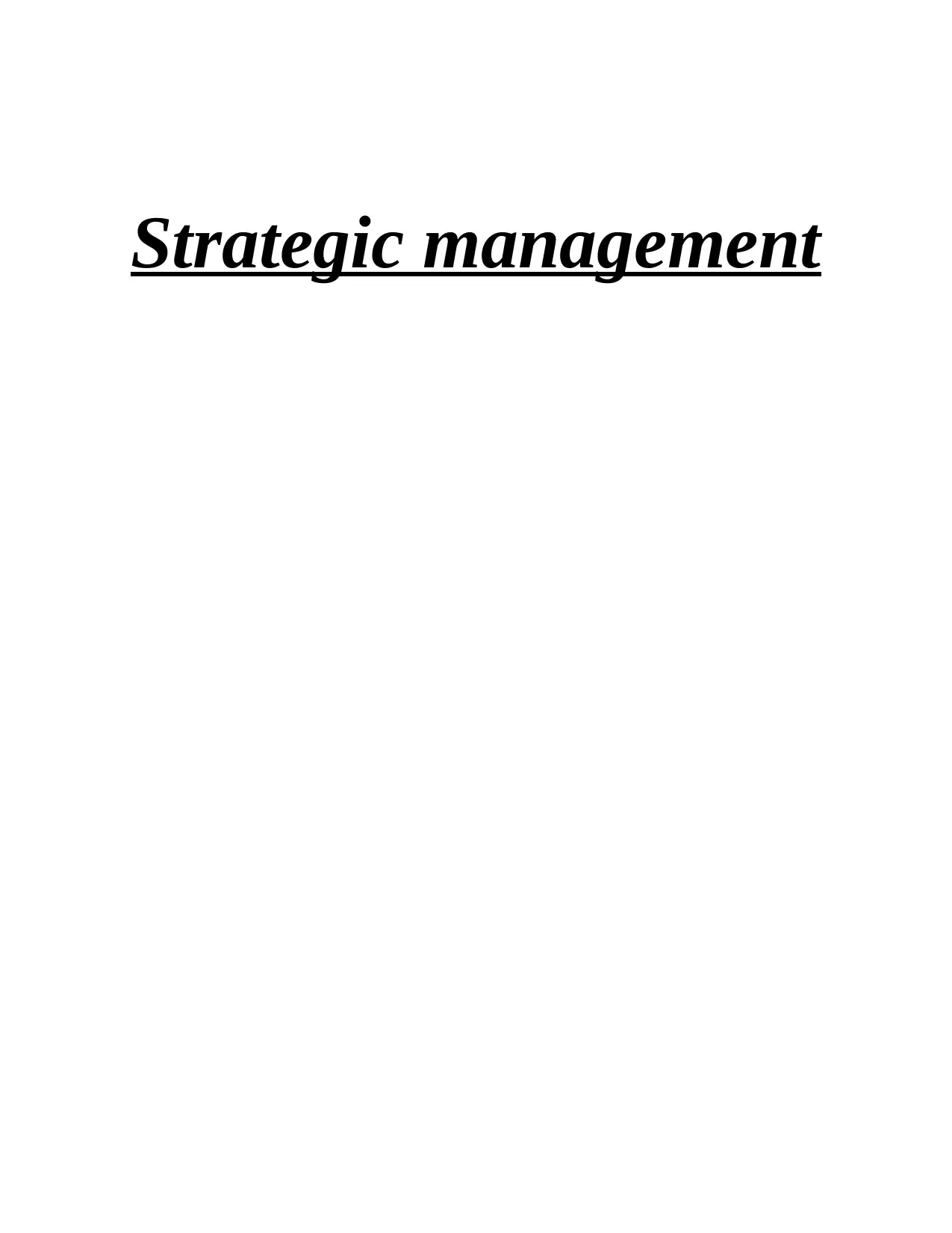
Strategic management
Paraphrase This Document
Need a fresh take? Get an instant paraphrase of this document with our AI Paraphraser
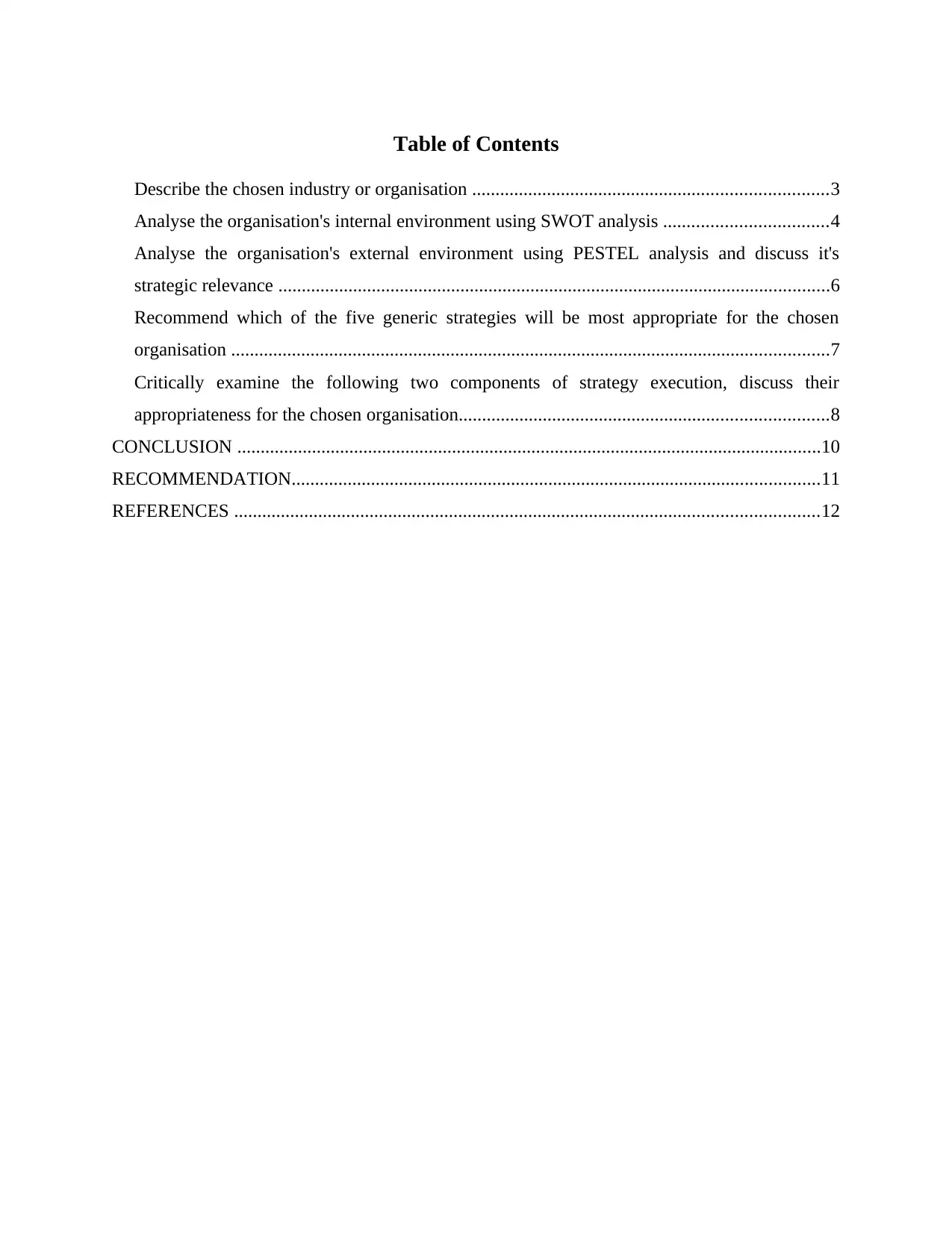
Table of Contents
Describe the chosen industry or organisation ............................................................................3
Analyse the organisation's internal environment using SWOT analysis ...................................4
Analyse the organisation's external environment using PESTEL analysis and discuss it's
strategic relevance ......................................................................................................................6
Recommend which of the five generic strategies will be most appropriate for the chosen
organisation ................................................................................................................................7
Critically examine the following two components of strategy execution, discuss their
appropriateness for the chosen organisation...............................................................................8
CONCLUSION .............................................................................................................................10
RECOMMENDATION.................................................................................................................11
REFERENCES .............................................................................................................................12
Describe the chosen industry or organisation ............................................................................3
Analyse the organisation's internal environment using SWOT analysis ...................................4
Analyse the organisation's external environment using PESTEL analysis and discuss it's
strategic relevance ......................................................................................................................6
Recommend which of the five generic strategies will be most appropriate for the chosen
organisation ................................................................................................................................7
Critically examine the following two components of strategy execution, discuss their
appropriateness for the chosen organisation...............................................................................8
CONCLUSION .............................................................................................................................10
RECOMMENDATION.................................................................................................................11
REFERENCES .............................................................................................................................12
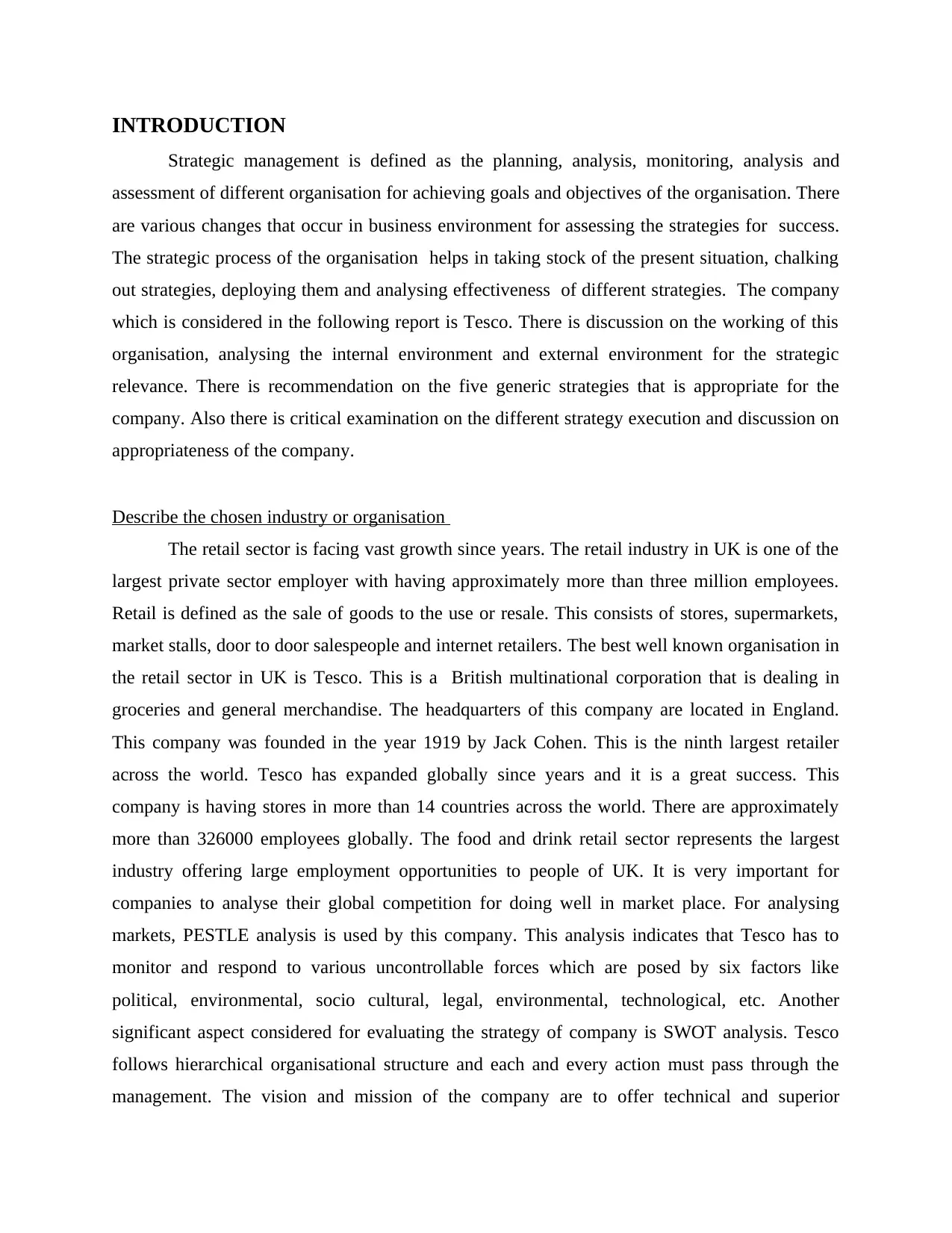
INTRODUCTION
Strategic management is defined as the planning, analysis, monitoring, analysis and
assessment of different organisation for achieving goals and objectives of the organisation. There
are various changes that occur in business environment for assessing the strategies for success.
The strategic process of the organisation helps in taking stock of the present situation, chalking
out strategies, deploying them and analysing effectiveness of different strategies. The company
which is considered in the following report is Tesco. There is discussion on the working of this
organisation, analysing the internal environment and external environment for the strategic
relevance. There is recommendation on the five generic strategies that is appropriate for the
company. Also there is critical examination on the different strategy execution and discussion on
appropriateness of the company.
Describe the chosen industry or organisation
The retail sector is facing vast growth since years. The retail industry in UK is one of the
largest private sector employer with having approximately more than three million employees.
Retail is defined as the sale of goods to the use or resale. This consists of stores, supermarkets,
market stalls, door to door salespeople and internet retailers. The best well known organisation in
the retail sector in UK is Tesco. This is a British multinational corporation that is dealing in
groceries and general merchandise. The headquarters of this company are located in England.
This company was founded in the year 1919 by Jack Cohen. This is the ninth largest retailer
across the world. Tesco has expanded globally since years and it is a great success. This
company is having stores in more than 14 countries across the world. There are approximately
more than 326000 employees globally. The food and drink retail sector represents the largest
industry offering large employment opportunities to people of UK. It is very important for
companies to analyse their global competition for doing well in market place. For analysing
markets, PESTLE analysis is used by this company. This analysis indicates that Tesco has to
monitor and respond to various uncontrollable forces which are posed by six factors like
political, environmental, socio cultural, legal, environmental, technological, etc. Another
significant aspect considered for evaluating the strategy of company is SWOT analysis. Tesco
follows hierarchical organisational structure and each and every action must pass through the
management. The vision and mission of the company are to offer technical and superior
Strategic management is defined as the planning, analysis, monitoring, analysis and
assessment of different organisation for achieving goals and objectives of the organisation. There
are various changes that occur in business environment for assessing the strategies for success.
The strategic process of the organisation helps in taking stock of the present situation, chalking
out strategies, deploying them and analysing effectiveness of different strategies. The company
which is considered in the following report is Tesco. There is discussion on the working of this
organisation, analysing the internal environment and external environment for the strategic
relevance. There is recommendation on the five generic strategies that is appropriate for the
company. Also there is critical examination on the different strategy execution and discussion on
appropriateness of the company.
Describe the chosen industry or organisation
The retail sector is facing vast growth since years. The retail industry in UK is one of the
largest private sector employer with having approximately more than three million employees.
Retail is defined as the sale of goods to the use or resale. This consists of stores, supermarkets,
market stalls, door to door salespeople and internet retailers. The best well known organisation in
the retail sector in UK is Tesco. This is a British multinational corporation that is dealing in
groceries and general merchandise. The headquarters of this company are located in England.
This company was founded in the year 1919 by Jack Cohen. This is the ninth largest retailer
across the world. Tesco has expanded globally since years and it is a great success. This
company is having stores in more than 14 countries across the world. There are approximately
more than 326000 employees globally. The food and drink retail sector represents the largest
industry offering large employment opportunities to people of UK. It is very important for
companies to analyse their global competition for doing well in market place. For analysing
markets, PESTLE analysis is used by this company. This analysis indicates that Tesco has to
monitor and respond to various uncontrollable forces which are posed by six factors like
political, environmental, socio cultural, legal, environmental, technological, etc. Another
significant aspect considered for evaluating the strategy of company is SWOT analysis. Tesco
follows hierarchical organisational structure and each and every action must pass through the
management. The vision and mission of the company are to offer technical and superior
⊘ This is a preview!⊘
Do you want full access?
Subscribe today to unlock all pages.

Trusted by 1+ million students worldwide
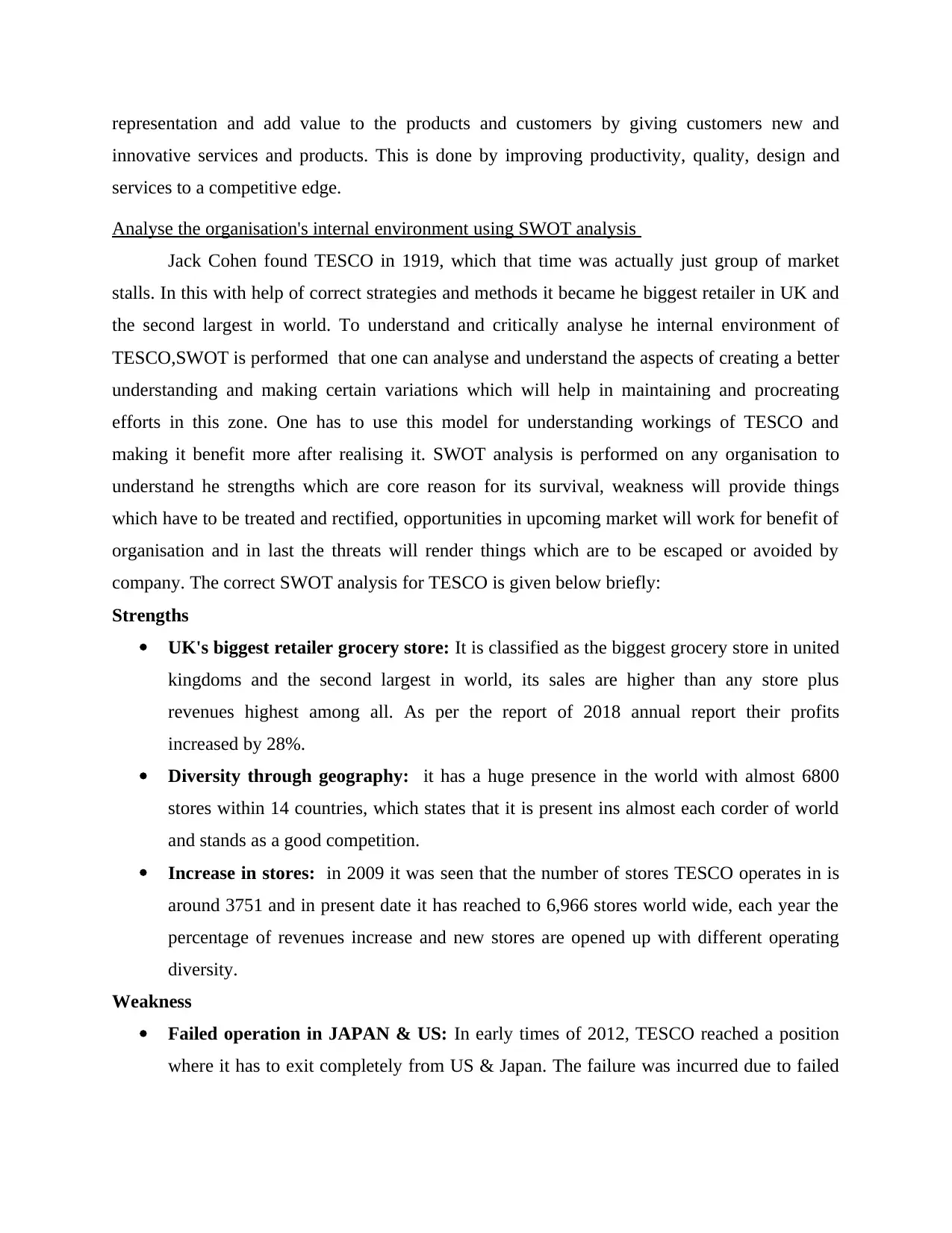
representation and add value to the products and customers by giving customers new and
innovative services and products. This is done by improving productivity, quality, design and
services to a competitive edge.
Analyse the organisation's internal environment using SWOT analysis
Jack Cohen found TESCO in 1919, which that time was actually just group of market
stalls. In this with help of correct strategies and methods it became he biggest retailer in UK and
the second largest in world. To understand and critically analyse he internal environment of
TESCO,SWOT is performed that one can analyse and understand the aspects of creating a better
understanding and making certain variations which will help in maintaining and procreating
efforts in this zone. One has to use this model for understanding workings of TESCO and
making it benefit more after realising it. SWOT analysis is performed on any organisation to
understand he strengths which are core reason for its survival, weakness will provide things
which have to be treated and rectified, opportunities in upcoming market will work for benefit of
organisation and in last the threats will render things which are to be escaped or avoided by
company. The correct SWOT analysis for TESCO is given below briefly:
Strengths
UK's biggest retailer grocery store: It is classified as the biggest grocery store in united
kingdoms and the second largest in world, its sales are higher than any store plus
revenues highest among all. As per the report of 2018 annual report their profits
increased by 28%.
Diversity through geography: it has a huge presence in the world with almost 6800
stores within 14 countries, which states that it is present ins almost each corder of world
and stands as a good competition.
Increase in stores: in 2009 it was seen that the number of stores TESCO operates in is
around 3751 and in present date it has reached to 6,966 stores world wide, each year the
percentage of revenues increase and new stores are opened up with different operating
diversity.
Weakness
Failed operation in JAPAN & US: In early times of 2012, TESCO reached a position
where it has to exit completely from US & Japan. The failure was incurred due to failed
innovative services and products. This is done by improving productivity, quality, design and
services to a competitive edge.
Analyse the organisation's internal environment using SWOT analysis
Jack Cohen found TESCO in 1919, which that time was actually just group of market
stalls. In this with help of correct strategies and methods it became he biggest retailer in UK and
the second largest in world. To understand and critically analyse he internal environment of
TESCO,SWOT is performed that one can analyse and understand the aspects of creating a better
understanding and making certain variations which will help in maintaining and procreating
efforts in this zone. One has to use this model for understanding workings of TESCO and
making it benefit more after realising it. SWOT analysis is performed on any organisation to
understand he strengths which are core reason for its survival, weakness will provide things
which have to be treated and rectified, opportunities in upcoming market will work for benefit of
organisation and in last the threats will render things which are to be escaped or avoided by
company. The correct SWOT analysis for TESCO is given below briefly:
Strengths
UK's biggest retailer grocery store: It is classified as the biggest grocery store in united
kingdoms and the second largest in world, its sales are higher than any store plus
revenues highest among all. As per the report of 2018 annual report their profits
increased by 28%.
Diversity through geography: it has a huge presence in the world with almost 6800
stores within 14 countries, which states that it is present ins almost each corder of world
and stands as a good competition.
Increase in stores: in 2009 it was seen that the number of stores TESCO operates in is
around 3751 and in present date it has reached to 6,966 stores world wide, each year the
percentage of revenues increase and new stores are opened up with different operating
diversity.
Weakness
Failed operation in JAPAN & US: In early times of 2012, TESCO reached a position
where it has to exit completely from US & Japan. The failure was incurred due to failed
Paraphrase This Document
Need a fresh take? Get an instant paraphrase of this document with our AI Paraphraser
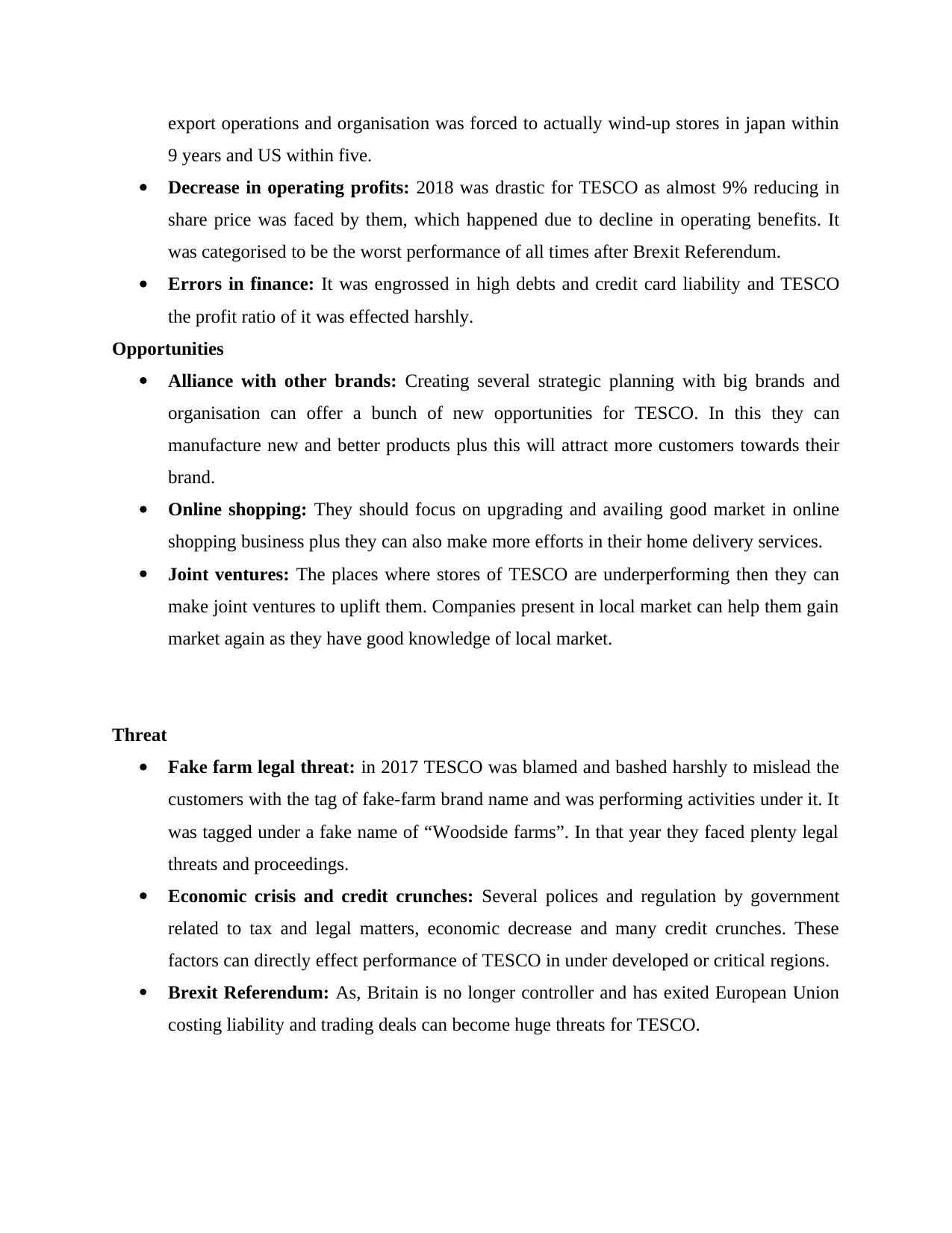
export operations and organisation was forced to actually wind-up stores in japan within
9 years and US within five.
Decrease in operating profits: 2018 was drastic for TESCO as almost 9% reducing in
share price was faced by them, which happened due to decline in operating benefits. It
was categorised to be the worst performance of all times after Brexit Referendum.
Errors in finance: It was engrossed in high debts and credit card liability and TESCO
the profit ratio of it was effected harshly.
Opportunities
Alliance with other brands: Creating several strategic planning with big brands and
organisation can offer a bunch of new opportunities for TESCO. In this they can
manufacture new and better products plus this will attract more customers towards their
brand.
Online shopping: They should focus on upgrading and availing good market in online
shopping business plus they can also make more efforts in their home delivery services.
Joint ventures: The places where stores of TESCO are underperforming then they can
make joint ventures to uplift them. Companies present in local market can help them gain
market again as they have good knowledge of local market.
Threat
Fake farm legal threat: in 2017 TESCO was blamed and bashed harshly to mislead the
customers with the tag of fake-farm brand name and was performing activities under it. It
was tagged under a fake name of “Woodside farms”. In that year they faced plenty legal
threats and proceedings.
Economic crisis and credit crunches: Several polices and regulation by government
related to tax and legal matters, economic decrease and many credit crunches. These
factors can directly effect performance of TESCO in under developed or critical regions.
Brexit Referendum: As, Britain is no longer controller and has exited European Union
costing liability and trading deals can become huge threats for TESCO.
9 years and US within five.
Decrease in operating profits: 2018 was drastic for TESCO as almost 9% reducing in
share price was faced by them, which happened due to decline in operating benefits. It
was categorised to be the worst performance of all times after Brexit Referendum.
Errors in finance: It was engrossed in high debts and credit card liability and TESCO
the profit ratio of it was effected harshly.
Opportunities
Alliance with other brands: Creating several strategic planning with big brands and
organisation can offer a bunch of new opportunities for TESCO. In this they can
manufacture new and better products plus this will attract more customers towards their
brand.
Online shopping: They should focus on upgrading and availing good market in online
shopping business plus they can also make more efforts in their home delivery services.
Joint ventures: The places where stores of TESCO are underperforming then they can
make joint ventures to uplift them. Companies present in local market can help them gain
market again as they have good knowledge of local market.
Threat
Fake farm legal threat: in 2017 TESCO was blamed and bashed harshly to mislead the
customers with the tag of fake-farm brand name and was performing activities under it. It
was tagged under a fake name of “Woodside farms”. In that year they faced plenty legal
threats and proceedings.
Economic crisis and credit crunches: Several polices and regulation by government
related to tax and legal matters, economic decrease and many credit crunches. These
factors can directly effect performance of TESCO in under developed or critical regions.
Brexit Referendum: As, Britain is no longer controller and has exited European Union
costing liability and trading deals can become huge threats for TESCO.
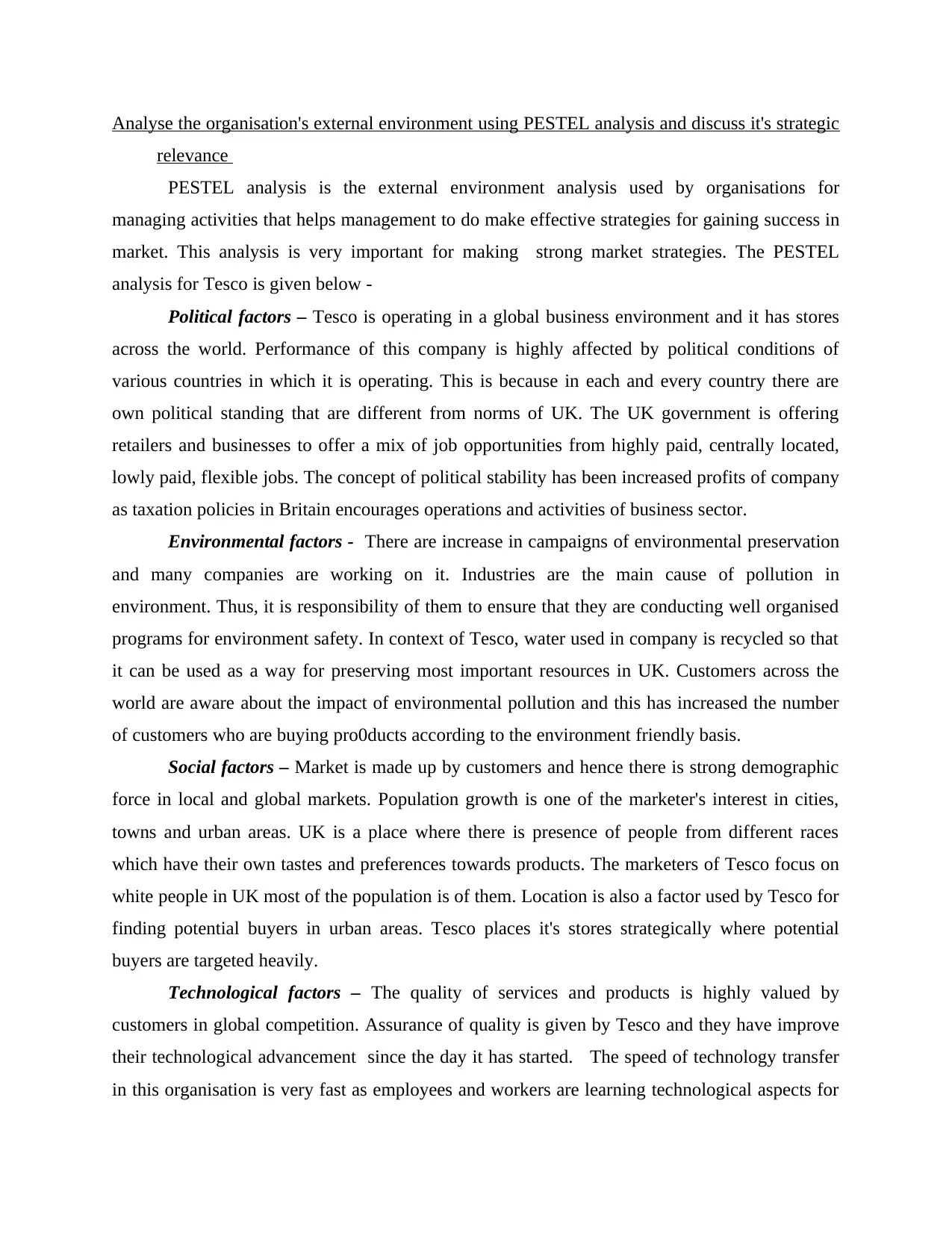
Analyse the organisation's external environment using PESTEL analysis and discuss it's strategic
relevance
PESTEL analysis is the external environment analysis used by organisations for
managing activities that helps management to do make effective strategies for gaining success in
market. This analysis is very important for making strong market strategies. The PESTEL
analysis for Tesco is given below -
Political factors – Tesco is operating in a global business environment and it has stores
across the world. Performance of this company is highly affected by political conditions of
various countries in which it is operating. This is because in each and every country there are
own political standing that are different from norms of UK. The UK government is offering
retailers and businesses to offer a mix of job opportunities from highly paid, centrally located,
lowly paid, flexible jobs. The concept of political stability has been increased profits of company
as taxation policies in Britain encourages operations and activities of business sector.
Environmental factors - There are increase in campaigns of environmental preservation
and many companies are working on it. Industries are the main cause of pollution in
environment. Thus, it is responsibility of them to ensure that they are conducting well organised
programs for environment safety. In context of Tesco, water used in company is recycled so that
it can be used as a way for preserving most important resources in UK. Customers across the
world are aware about the impact of environmental pollution and this has increased the number
of customers who are buying pro0ducts according to the environment friendly basis.
Social factors – Market is made up by customers and hence there is strong demographic
force in local and global markets. Population growth is one of the marketer's interest in cities,
towns and urban areas. UK is a place where there is presence of people from different races
which have their own tastes and preferences towards products. The marketers of Tesco focus on
white people in UK most of the population is of them. Location is also a factor used by Tesco for
finding potential buyers in urban areas. Tesco places it's stores strategically where potential
buyers are targeted heavily.
Technological factors – The quality of services and products is highly valued by
customers in global competition. Assurance of quality is given by Tesco and they have improve
their technological advancement since the day it has started. The speed of technology transfer
in this organisation is very fast as employees and workers are learning technological aspects for
relevance
PESTEL analysis is the external environment analysis used by organisations for
managing activities that helps management to do make effective strategies for gaining success in
market. This analysis is very important for making strong market strategies. The PESTEL
analysis for Tesco is given below -
Political factors – Tesco is operating in a global business environment and it has stores
across the world. Performance of this company is highly affected by political conditions of
various countries in which it is operating. This is because in each and every country there are
own political standing that are different from norms of UK. The UK government is offering
retailers and businesses to offer a mix of job opportunities from highly paid, centrally located,
lowly paid, flexible jobs. The concept of political stability has been increased profits of company
as taxation policies in Britain encourages operations and activities of business sector.
Environmental factors - There are increase in campaigns of environmental preservation
and many companies are working on it. Industries are the main cause of pollution in
environment. Thus, it is responsibility of them to ensure that they are conducting well organised
programs for environment safety. In context of Tesco, water used in company is recycled so that
it can be used as a way for preserving most important resources in UK. Customers across the
world are aware about the impact of environmental pollution and this has increased the number
of customers who are buying pro0ducts according to the environment friendly basis.
Social factors – Market is made up by customers and hence there is strong demographic
force in local and global markets. Population growth is one of the marketer's interest in cities,
towns and urban areas. UK is a place where there is presence of people from different races
which have their own tastes and preferences towards products. The marketers of Tesco focus on
white people in UK most of the population is of them. Location is also a factor used by Tesco for
finding potential buyers in urban areas. Tesco places it's stores strategically where potential
buyers are targeted heavily.
Technological factors – The quality of services and products is highly valued by
customers in global competition. Assurance of quality is given by Tesco and they have improve
their technological advancement since the day it has started. The speed of technology transfer
in this organisation is very fast as employees and workers are learning technological aspects for
⊘ This is a preview!⊘
Do you want full access?
Subscribe today to unlock all pages.

Trusted by 1+ million students worldwide
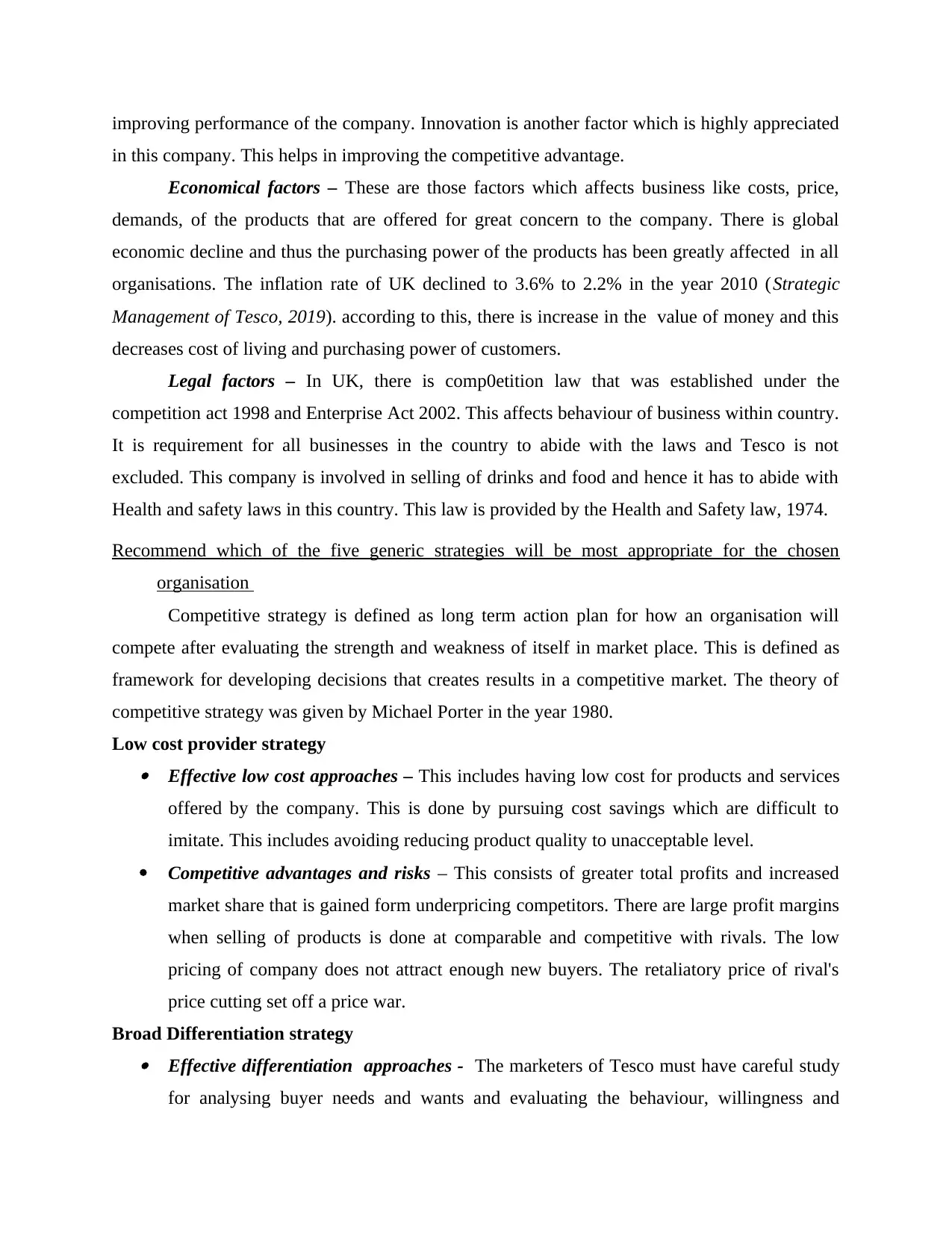
improving performance of the company. Innovation is another factor which is highly appreciated
in this company. This helps in improving the competitive advantage.
Economical factors – These are those factors which affects business like costs, price,
demands, of the products that are offered for great concern to the company. There is global
economic decline and thus the purchasing power of the products has been greatly affected in all
organisations. The inflation rate of UK declined to 3.6% to 2.2% in the year 2010 (Strategic
Management of Tesco, 2019). according to this, there is increase in the value of money and this
decreases cost of living and purchasing power of customers.
Legal factors – In UK, there is comp0etition law that was established under the
competition act 1998 and Enterprise Act 2002. This affects behaviour of business within country.
It is requirement for all businesses in the country to abide with the laws and Tesco is not
excluded. This company is involved in selling of drinks and food and hence it has to abide with
Health and safety laws in this country. This law is provided by the Health and Safety law, 1974.
Recommend which of the five generic strategies will be most appropriate for the chosen
organisation
Competitive strategy is defined as long term action plan for how an organisation will
compete after evaluating the strength and weakness of itself in market place. This is defined as
framework for developing decisions that creates results in a competitive market. The theory of
competitive strategy was given by Michael Porter in the year 1980.
Low cost provider strategy Effective low cost approaches – This includes having low cost for products and services
offered by the company. This is done by pursuing cost savings which are difficult to
imitate. This includes avoiding reducing product quality to unacceptable level.
Competitive advantages and risks – This consists of greater total profits and increased
market share that is gained form underpricing competitors. There are large profit margins
when selling of products is done at comparable and competitive with rivals. The low
pricing of company does not attract enough new buyers. The retaliatory price of rival's
price cutting set off a price war.
Broad Differentiation strategy Effective differentiation approaches - The marketers of Tesco must have careful study
for analysing buyer needs and wants and evaluating the behaviour, willingness and
in this company. This helps in improving the competitive advantage.
Economical factors – These are those factors which affects business like costs, price,
demands, of the products that are offered for great concern to the company. There is global
economic decline and thus the purchasing power of the products has been greatly affected in all
organisations. The inflation rate of UK declined to 3.6% to 2.2% in the year 2010 (Strategic
Management of Tesco, 2019). according to this, there is increase in the value of money and this
decreases cost of living and purchasing power of customers.
Legal factors – In UK, there is comp0etition law that was established under the
competition act 1998 and Enterprise Act 2002. This affects behaviour of business within country.
It is requirement for all businesses in the country to abide with the laws and Tesco is not
excluded. This company is involved in selling of drinks and food and hence it has to abide with
Health and safety laws in this country. This law is provided by the Health and Safety law, 1974.
Recommend which of the five generic strategies will be most appropriate for the chosen
organisation
Competitive strategy is defined as long term action plan for how an organisation will
compete after evaluating the strength and weakness of itself in market place. This is defined as
framework for developing decisions that creates results in a competitive market. The theory of
competitive strategy was given by Michael Porter in the year 1980.
Low cost provider strategy Effective low cost approaches – This includes having low cost for products and services
offered by the company. This is done by pursuing cost savings which are difficult to
imitate. This includes avoiding reducing product quality to unacceptable level.
Competitive advantages and risks – This consists of greater total profits and increased
market share that is gained form underpricing competitors. There are large profit margins
when selling of products is done at comparable and competitive with rivals. The low
pricing of company does not attract enough new buyers. The retaliatory price of rival's
price cutting set off a price war.
Broad Differentiation strategy Effective differentiation approaches - The marketers of Tesco must have careful study
for analysing buyer needs and wants and evaluating the behaviour, willingness and
Paraphrase This Document
Need a fresh take? Get an instant paraphrase of this document with our AI Paraphraser
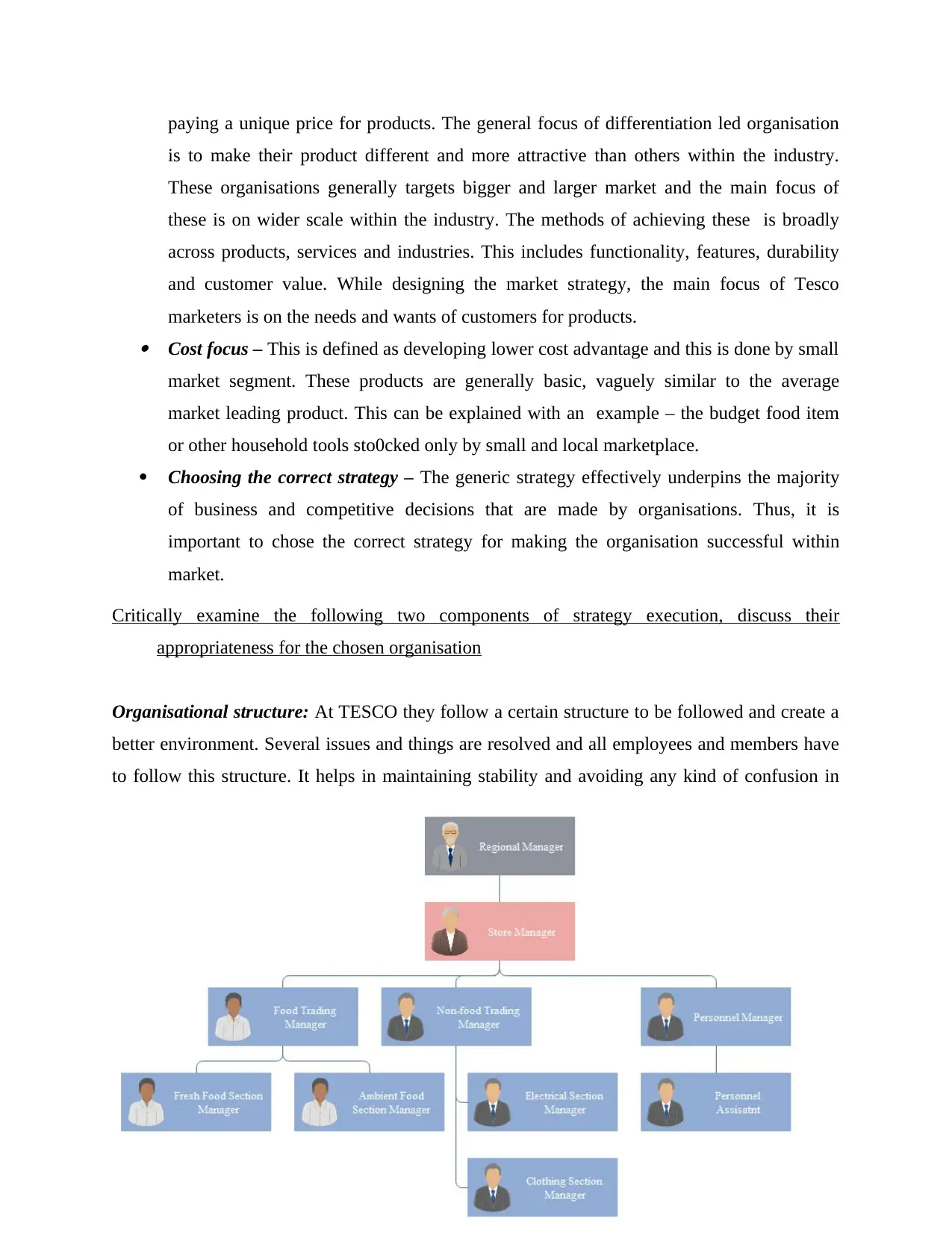
paying a unique price for products. The general focus of differentiation led organisation
is to make their product different and more attractive than others within the industry.
These organisations generally targets bigger and larger market and the main focus of
these is on wider scale within the industry. The methods of achieving these is broadly
across products, services and industries. This includes functionality, features, durability
and customer value. While designing the market strategy, the main focus of Tesco
marketers is on the needs and wants of customers for products. Cost focus – This is defined as developing lower cost advantage and this is done by small
market segment. These products are generally basic, vaguely similar to the average
market leading product. This can be explained with an example – the budget food item
or other household tools sto0cked only by small and local marketplace.
Choosing the correct strategy – The generic strategy effectively underpins the majority
of business and competitive decisions that are made by organisations. Thus, it is
important to chose the correct strategy for making the organisation successful within
market.
Critically examine the following two components of strategy execution, discuss their
appropriateness for the chosen organisation
Organisational structure: At TESCO they follow a certain structure to be followed and create a
better environment. Several issues and things are resolved and all employees and members have
to follow this structure. It helps in maintaining stability and avoiding any kind of confusion in
is to make their product different and more attractive than others within the industry.
These organisations generally targets bigger and larger market and the main focus of
these is on wider scale within the industry. The methods of achieving these is broadly
across products, services and industries. This includes functionality, features, durability
and customer value. While designing the market strategy, the main focus of Tesco
marketers is on the needs and wants of customers for products. Cost focus – This is defined as developing lower cost advantage and this is done by small
market segment. These products are generally basic, vaguely similar to the average
market leading product. This can be explained with an example – the budget food item
or other household tools sto0cked only by small and local marketplace.
Choosing the correct strategy – The generic strategy effectively underpins the majority
of business and competitive decisions that are made by organisations. Thus, it is
important to chose the correct strategy for making the organisation successful within
market.
Critically examine the following two components of strategy execution, discuss their
appropriateness for the chosen organisation
Organisational structure: At TESCO they follow a certain structure to be followed and create a
better environment. Several issues and things are resolved and all employees and members have
to follow this structure. It helps in maintaining stability and avoiding any kind of confusion in
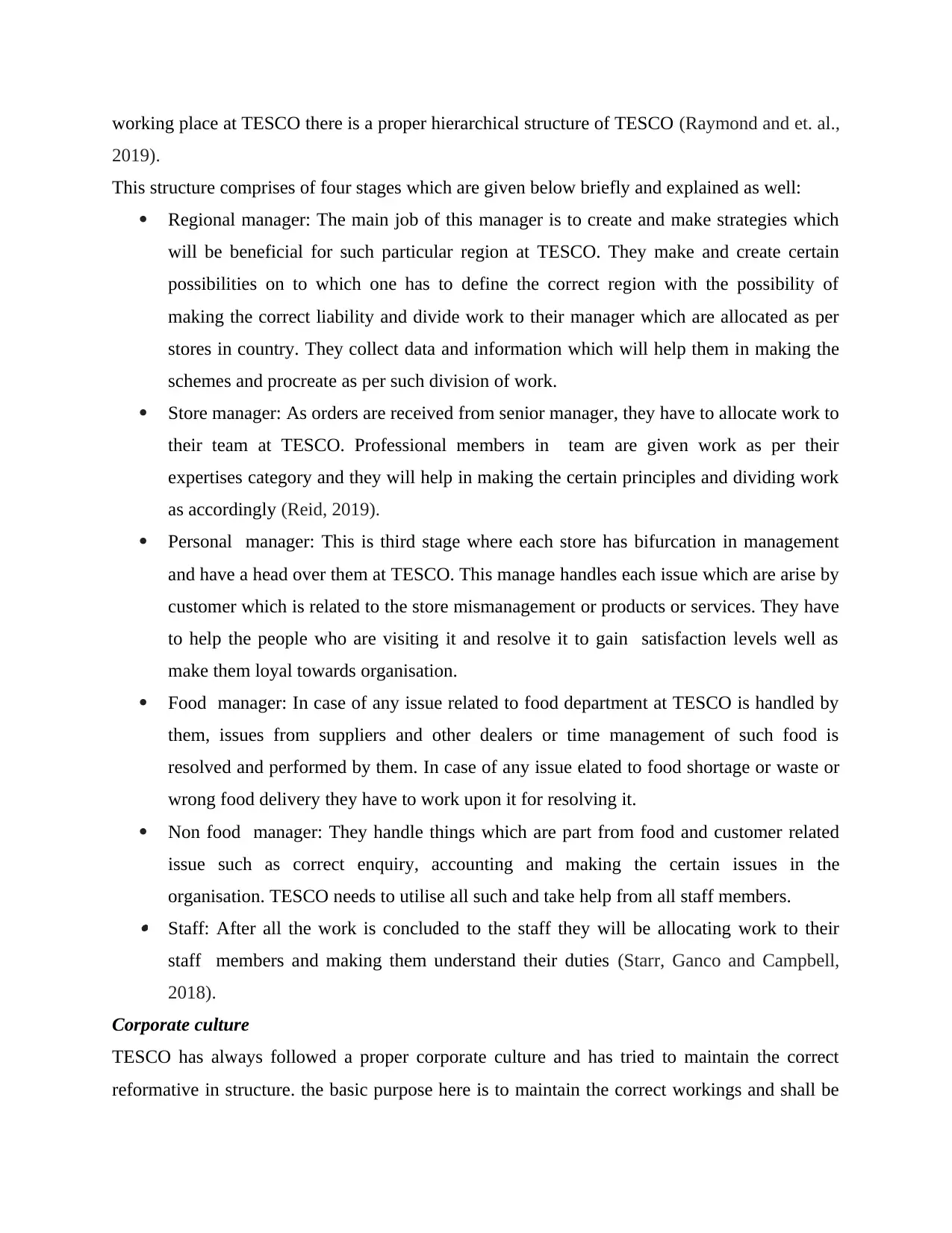
working place at TESCO there is a proper hierarchical structure of TESCO (Raymond and et. al.,
2019).
This structure comprises of four stages which are given below briefly and explained as well:
Regional manager: The main job of this manager is to create and make strategies which
will be beneficial for such particular region at TESCO. They make and create certain
possibilities on to which one has to define the correct region with the possibility of
making the correct liability and divide work to their manager which are allocated as per
stores in country. They collect data and information which will help them in making the
schemes and procreate as per such division of work.
Store manager: As orders are received from senior manager, they have to allocate work to
their team at TESCO. Professional members in team are given work as per their
expertises category and they will help in making the certain principles and dividing work
as accordingly (Reid, 2019).
Personal manager: This is third stage where each store has bifurcation in management
and have a head over them at TESCO. This manage handles each issue which are arise by
customer which is related to the store mismanagement or products or services. They have
to help the people who are visiting it and resolve it to gain satisfaction levels well as
make them loyal towards organisation.
Food manager: In case of any issue related to food department at TESCO is handled by
them, issues from suppliers and other dealers or time management of such food is
resolved and performed by them. In case of any issue elated to food shortage or waste or
wrong food delivery they have to work upon it for resolving it.
Non food manager: They handle things which are part from food and customer related
issue such as correct enquiry, accounting and making the certain issues in the
organisation. TESCO needs to utilise all such and take help from all staff members. Staff: After all the work is concluded to the staff they will be allocating work to their
staff members and making them understand their duties (Starr, Ganco and Campbell,
2018).
Corporate culture
TESCO has always followed a proper corporate culture and has tried to maintain the correct
reformative in structure. the basic purpose here is to maintain the correct workings and shall be
2019).
This structure comprises of four stages which are given below briefly and explained as well:
Regional manager: The main job of this manager is to create and make strategies which
will be beneficial for such particular region at TESCO. They make and create certain
possibilities on to which one has to define the correct region with the possibility of
making the correct liability and divide work to their manager which are allocated as per
stores in country. They collect data and information which will help them in making the
schemes and procreate as per such division of work.
Store manager: As orders are received from senior manager, they have to allocate work to
their team at TESCO. Professional members in team are given work as per their
expertises category and they will help in making the certain principles and dividing work
as accordingly (Reid, 2019).
Personal manager: This is third stage where each store has bifurcation in management
and have a head over them at TESCO. This manage handles each issue which are arise by
customer which is related to the store mismanagement or products or services. They have
to help the people who are visiting it and resolve it to gain satisfaction levels well as
make them loyal towards organisation.
Food manager: In case of any issue related to food department at TESCO is handled by
them, issues from suppliers and other dealers or time management of such food is
resolved and performed by them. In case of any issue elated to food shortage or waste or
wrong food delivery they have to work upon it for resolving it.
Non food manager: They handle things which are part from food and customer related
issue such as correct enquiry, accounting and making the certain issues in the
organisation. TESCO needs to utilise all such and take help from all staff members. Staff: After all the work is concluded to the staff they will be allocating work to their
staff members and making them understand their duties (Starr, Ganco and Campbell,
2018).
Corporate culture
TESCO has always followed a proper corporate culture and has tried to maintain the correct
reformative in structure. the basic purpose here is to maintain the correct workings and shall be
⊘ This is a preview!⊘
Do you want full access?
Subscribe today to unlock all pages.

Trusted by 1+ million students worldwide
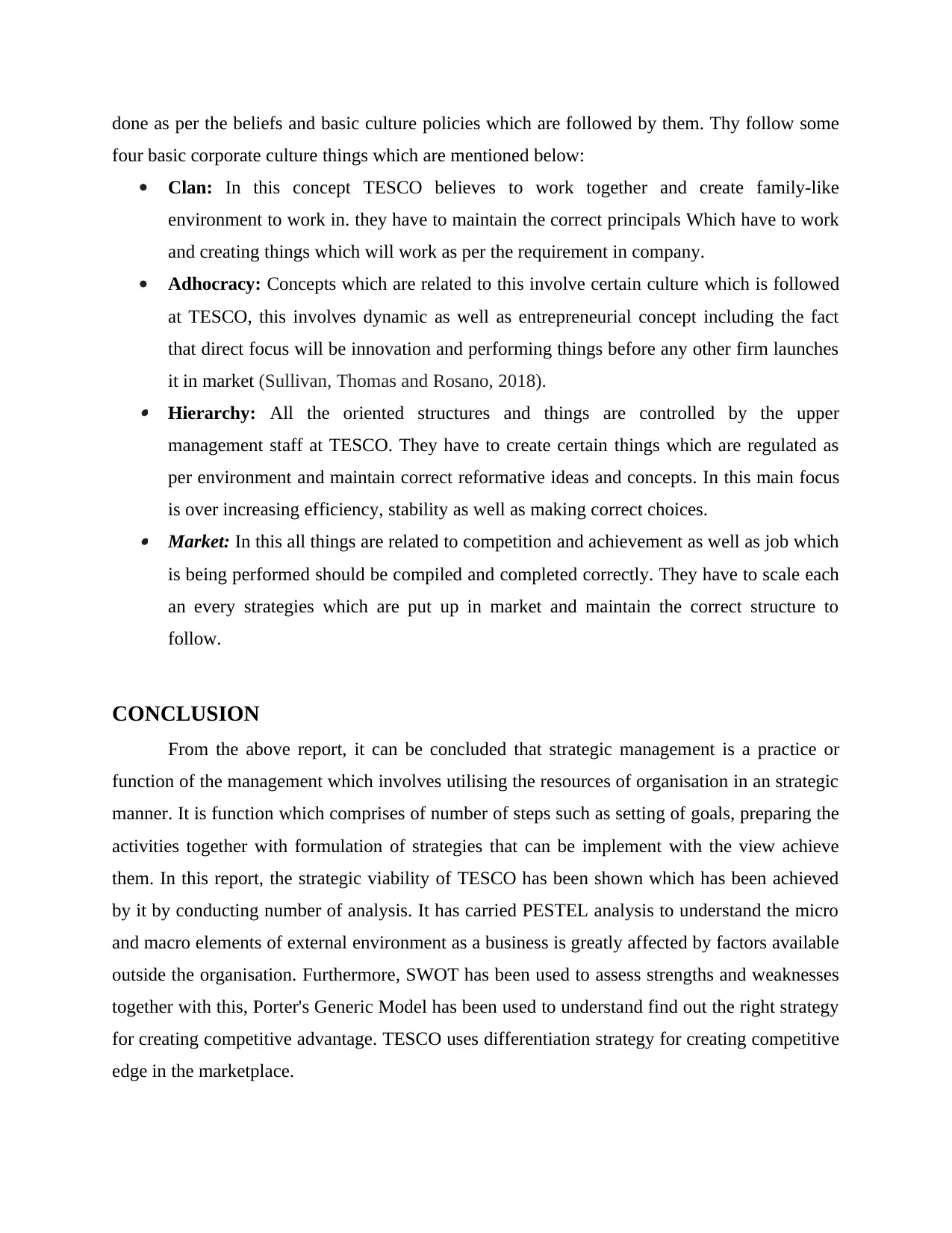
done as per the beliefs and basic culture policies which are followed by them. Thy follow some
four basic corporate culture things which are mentioned below:
Clan: In this concept TESCO believes to work together and create family-like
environment to work in. they have to maintain the correct principals Which have to work
and creating things which will work as per the requirement in company.
Adhocracy: Concepts which are related to this involve certain culture which is followed
at TESCO, this involves dynamic as well as entrepreneurial concept including the fact
that direct focus will be innovation and performing things before any other firm launches
it in market (Sullivan, Thomas and Rosano, 2018). Hierarchy: All the oriented structures and things are controlled by the upper
management staff at TESCO. They have to create certain things which are regulated as
per environment and maintain correct reformative ideas and concepts. In this main focus
is over increasing efficiency, stability as well as making correct choices. Market: In this all things are related to competition and achievement as well as job which
is being performed should be compiled and completed correctly. They have to scale each
an every strategies which are put up in market and maintain the correct structure to
follow.
CONCLUSION
From the above report, it can be concluded that strategic management is a practice or
function of the management which involves utilising the resources of organisation in an strategic
manner. It is function which comprises of number of steps such as setting of goals, preparing the
activities together with formulation of strategies that can be implement with the view achieve
them. In this report, the strategic viability of TESCO has been shown which has been achieved
by it by conducting number of analysis. It has carried PESTEL analysis to understand the micro
and macro elements of external environment as a business is greatly affected by factors available
outside the organisation. Furthermore, SWOT has been used to assess strengths and weaknesses
together with this, Porter's Generic Model has been used to understand find out the right strategy
for creating competitive advantage. TESCO uses differentiation strategy for creating competitive
edge in the marketplace.
four basic corporate culture things which are mentioned below:
Clan: In this concept TESCO believes to work together and create family-like
environment to work in. they have to maintain the correct principals Which have to work
and creating things which will work as per the requirement in company.
Adhocracy: Concepts which are related to this involve certain culture which is followed
at TESCO, this involves dynamic as well as entrepreneurial concept including the fact
that direct focus will be innovation and performing things before any other firm launches
it in market (Sullivan, Thomas and Rosano, 2018). Hierarchy: All the oriented structures and things are controlled by the upper
management staff at TESCO. They have to create certain things which are regulated as
per environment and maintain correct reformative ideas and concepts. In this main focus
is over increasing efficiency, stability as well as making correct choices. Market: In this all things are related to competition and achievement as well as job which
is being performed should be compiled and completed correctly. They have to scale each
an every strategies which are put up in market and maintain the correct structure to
follow.
CONCLUSION
From the above report, it can be concluded that strategic management is a practice or
function of the management which involves utilising the resources of organisation in an strategic
manner. It is function which comprises of number of steps such as setting of goals, preparing the
activities together with formulation of strategies that can be implement with the view achieve
them. In this report, the strategic viability of TESCO has been shown which has been achieved
by it by conducting number of analysis. It has carried PESTEL analysis to understand the micro
and macro elements of external environment as a business is greatly affected by factors available
outside the organisation. Furthermore, SWOT has been used to assess strengths and weaknesses
together with this, Porter's Generic Model has been used to understand find out the right strategy
for creating competitive advantage. TESCO uses differentiation strategy for creating competitive
edge in the marketplace.
Paraphrase This Document
Need a fresh take? Get an instant paraphrase of this document with our AI Paraphraser
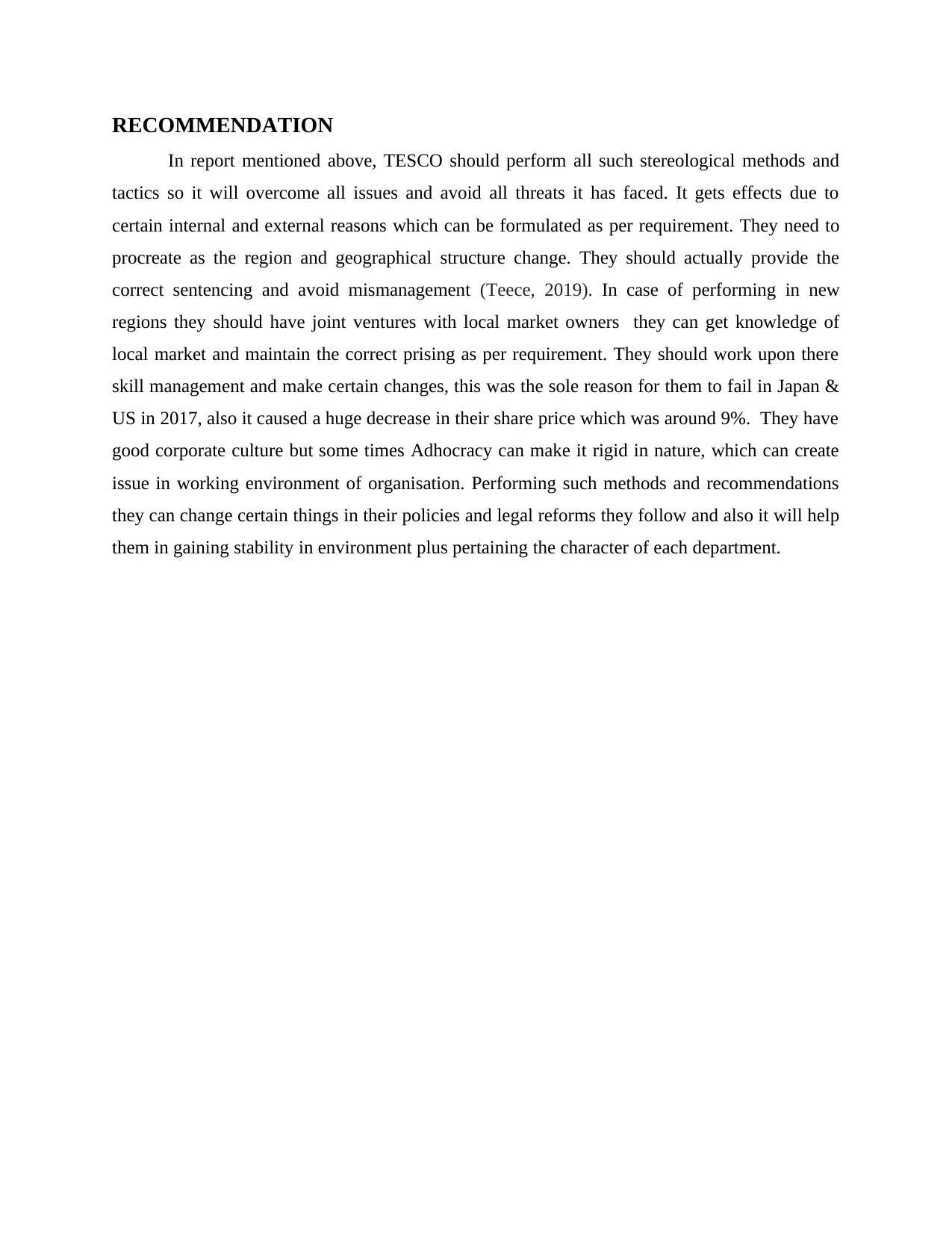
RECOMMENDATION
In report mentioned above, TESCO should perform all such stereological methods and
tactics so it will overcome all issues and avoid all threats it has faced. It gets effects due to
certain internal and external reasons which can be formulated as per requirement. They need to
procreate as the region and geographical structure change. They should actually provide the
correct sentencing and avoid mismanagement (Teece, 2019). In case of performing in new
regions they should have joint ventures with local market owners they can get knowledge of
local market and maintain the correct prising as per requirement. They should work upon there
skill management and make certain changes, this was the sole reason for them to fail in Japan &
US in 2017, also it caused a huge decrease in their share price which was around 9%. They have
good corporate culture but some times Adhocracy can make it rigid in nature, which can create
issue in working environment of organisation. Performing such methods and recommendations
they can change certain things in their policies and legal reforms they follow and also it will help
them in gaining stability in environment plus pertaining the character of each department.
In report mentioned above, TESCO should perform all such stereological methods and
tactics so it will overcome all issues and avoid all threats it has faced. It gets effects due to
certain internal and external reasons which can be formulated as per requirement. They need to
procreate as the region and geographical structure change. They should actually provide the
correct sentencing and avoid mismanagement (Teece, 2019). In case of performing in new
regions they should have joint ventures with local market owners they can get knowledge of
local market and maintain the correct prising as per requirement. They should work upon there
skill management and make certain changes, this was the sole reason for them to fail in Japan &
US in 2017, also it caused a huge decrease in their share price which was around 9%. They have
good corporate culture but some times Adhocracy can make it rigid in nature, which can create
issue in working environment of organisation. Performing such methods and recommendations
they can change certain things in their policies and legal reforms they follow and also it will help
them in gaining stability in environment plus pertaining the character of each department.
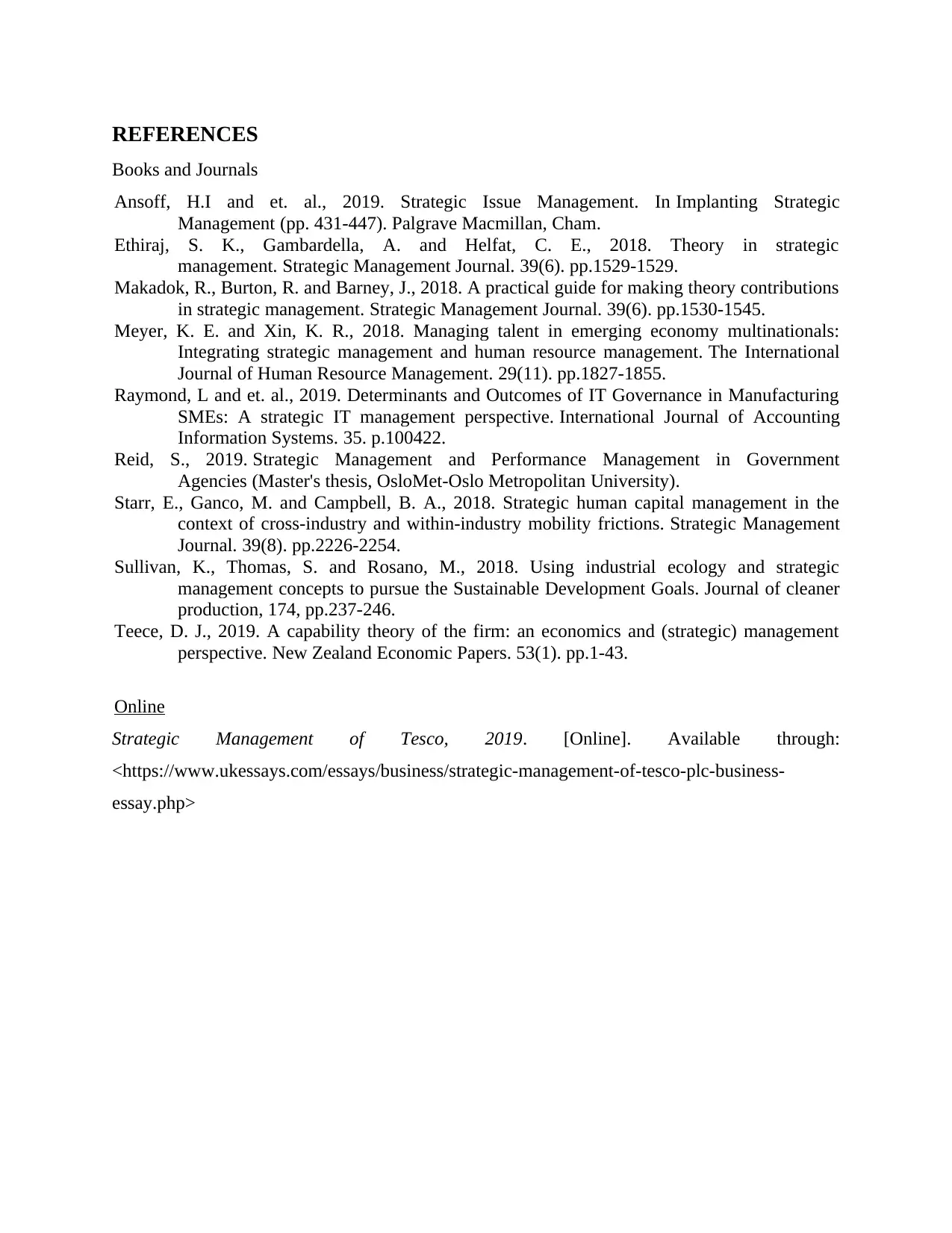
REFERENCES
Books and Journals
Ansoff, H.I and et. al., 2019. Strategic Issue Management. In Implanting Strategic
Management (pp. 431-447). Palgrave Macmillan, Cham.
Ethiraj, S. K., Gambardella, A. and Helfat, C. E., 2018. Theory in strategic
management. Strategic Management Journal. 39(6). pp.1529-1529.
Makadok, R., Burton, R. and Barney, J., 2018. A practical guide for making theory contributions
in strategic management. Strategic Management Journal. 39(6). pp.1530-1545.
Meyer, K. E. and Xin, K. R., 2018. Managing talent in emerging economy multinationals:
Integrating strategic management and human resource management. The International
Journal of Human Resource Management. 29(11). pp.1827-1855.
Raymond, L and et. al., 2019. Determinants and Outcomes of IT Governance in Manufacturing
SMEs: A strategic IT management perspective. International Journal of Accounting
Information Systems. 35. p.100422.
Reid, S., 2019. Strategic Management and Performance Management in Government
Agencies (Master's thesis, OsloMet-Oslo Metropolitan University).
Starr, E., Ganco, M. and Campbell, B. A., 2018. Strategic human capital management in the
context of cross‐industry and within‐industry mobility frictions. Strategic Management
Journal. 39(8). pp.2226-2254.
Sullivan, K., Thomas, S. and Rosano, M., 2018. Using industrial ecology and strategic
management concepts to pursue the Sustainable Development Goals. Journal of cleaner
production, 174, pp.237-246.
Teece, D. J., 2019. A capability theory of the firm: an economics and (strategic) management
perspective. New Zealand Economic Papers. 53(1). pp.1-43.
Online
Strategic Management of Tesco, 2019. [Online]. Available through:
<https://www.ukessays.com/essays/business/strategic-management-of-tesco-plc-business-
essay.php>
Books and Journals
Ansoff, H.I and et. al., 2019. Strategic Issue Management. In Implanting Strategic
Management (pp. 431-447). Palgrave Macmillan, Cham.
Ethiraj, S. K., Gambardella, A. and Helfat, C. E., 2018. Theory in strategic
management. Strategic Management Journal. 39(6). pp.1529-1529.
Makadok, R., Burton, R. and Barney, J., 2018. A practical guide for making theory contributions
in strategic management. Strategic Management Journal. 39(6). pp.1530-1545.
Meyer, K. E. and Xin, K. R., 2018. Managing talent in emerging economy multinationals:
Integrating strategic management and human resource management. The International
Journal of Human Resource Management. 29(11). pp.1827-1855.
Raymond, L and et. al., 2019. Determinants and Outcomes of IT Governance in Manufacturing
SMEs: A strategic IT management perspective. International Journal of Accounting
Information Systems. 35. p.100422.
Reid, S., 2019. Strategic Management and Performance Management in Government
Agencies (Master's thesis, OsloMet-Oslo Metropolitan University).
Starr, E., Ganco, M. and Campbell, B. A., 2018. Strategic human capital management in the
context of cross‐industry and within‐industry mobility frictions. Strategic Management
Journal. 39(8). pp.2226-2254.
Sullivan, K., Thomas, S. and Rosano, M., 2018. Using industrial ecology and strategic
management concepts to pursue the Sustainable Development Goals. Journal of cleaner
production, 174, pp.237-246.
Teece, D. J., 2019. A capability theory of the firm: an economics and (strategic) management
perspective. New Zealand Economic Papers. 53(1). pp.1-43.
Online
Strategic Management of Tesco, 2019. [Online]. Available through:
<https://www.ukessays.com/essays/business/strategic-management-of-tesco-plc-business-
essay.php>
⊘ This is a preview!⊘
Do you want full access?
Subscribe today to unlock all pages.

Trusted by 1+ million students worldwide
1 out of 12
Related Documents
Your All-in-One AI-Powered Toolkit for Academic Success.
+13062052269
info@desklib.com
Available 24*7 on WhatsApp / Email
![[object Object]](/_next/static/media/star-bottom.7253800d.svg)
Unlock your academic potential
Copyright © 2020–2025 A2Z Services. All Rights Reserved. Developed and managed by ZUCOL.




